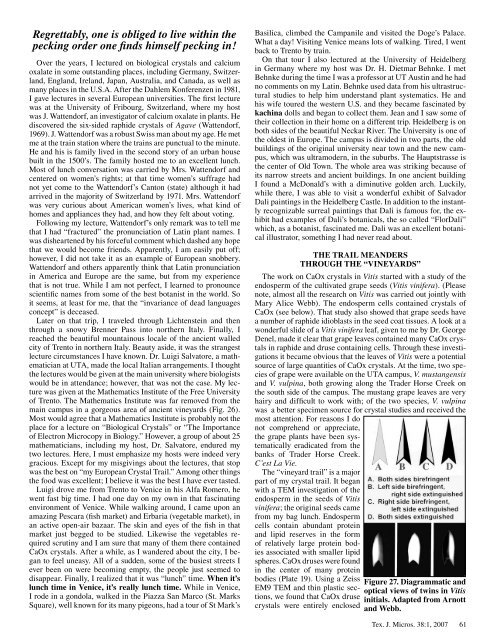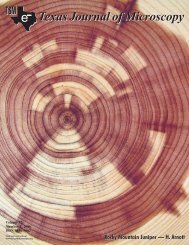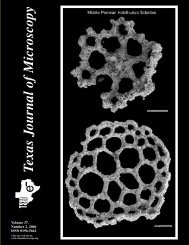Texas Journal of Microscopy - Texas Society for Microscopy
Texas Journal of Microscopy - Texas Society for Microscopy
Texas Journal of Microscopy - Texas Society for Microscopy
You also want an ePaper? Increase the reach of your titles
YUMPU automatically turns print PDFs into web optimized ePapers that Google loves.
Regrettably, one is obliged to live within the<br />
pecking order one finds himself pecking in!<br />
Over the years, I lectured on biological crystals and calcium<br />
oxalate in some outstanding places, including Germany, Switzerland,<br />
England, Ireland, Japan, Australia, and Canada, as well as<br />
many places in the U.S.A. After the Dahlem Konferenzen in 98 ,<br />
I gave lectures in several European universities. The first lecture<br />
was at the University <strong>of</strong> Fribourg, Switzerland, where my host<br />
was J. Wattendorf, an investigator <strong>of</strong> calcium oxalate in plants. He<br />
discovered the six-sided raphide crystals <strong>of</strong> Agave (Wattendorf,<br />
969). J. Wattendorf was a robust Swiss man about my age. He met<br />
me at the train station where the trains are punctual to the minute.<br />
He and his is family lived in the second story <strong>of</strong> an urban house<br />
built in the 500’s. The family hosted me to an excellent lunch.<br />
Most <strong>of</strong> lunch conversation was carried by Mrs. Wattendorf and<br />
centered on women’s rights; at that time women’s suffrage had<br />
not yet come to the Wattendorf’s Canton (state) although it had<br />
arrived in the majority <strong>of</strong> Switzerland by 97 . Mrs. Wattendorf<br />
was very curious about American women’s lives, what kind <strong>of</strong><br />
homes and appliances they had, and how they felt about voting.<br />
Following my lecture, Wattendorf’s only remark was to tell me<br />
that I had “fractured” the pronunciation <strong>of</strong> Latin plant names. I<br />
was disheartened by his <strong>for</strong>ceful comment which dashed any hope<br />
that we would become friends. Apparently, I am easily put <strong>of</strong>f;<br />
however, I did not take it as an example <strong>of</strong> European snobbery.<br />
Wattendorf and others apparently think that Latin pronunciation<br />
in America and Europe are the same, but from my experience<br />
that is not true. While I am not perfect, I learned to pronounce<br />
scientific names from some <strong>of</strong> the best botanist in the world. So<br />
it seems, at least <strong>for</strong> me, that the “invariance <strong>of</strong> dead languages<br />
concept” is deceased.<br />
Later on that trip, I traveled through Lichtenstein and then<br />
through a snowy Brenner Pass into northern Italy. Finally, I<br />
reached the beautiful mountainous locale <strong>of</strong> the ancient walled<br />
city <strong>of</strong> Trento in northern Italy. Beauty aside, it was the strangest<br />
lecture circumstances I have known. Dr. Luigi Salvatore, a mathematician<br />
at UTA, made the local Italian arrangements. I thought<br />
the lectures would be given at the main university where biologists<br />
would be in attendance; however, that was not the case. My lecture<br />
was given at the Mathematics Institute <strong>of</strong> the Free University<br />
<strong>of</strong> Trento. The Mathematics Institute was far removed from the<br />
main campus in a gorgeous area <strong>of</strong> ancient vineyards (Fig. 26).<br />
Most would agree that a Mathematics Institute is probably not the<br />
place <strong>for</strong> a lecture on “Biological Crystals” or “The Importance<br />
<strong>of</strong> Electron Microcopy in Biology.” However, a group <strong>of</strong> about 25<br />
mathematicians, including my host, Dr. Salvatore, endured my<br />
two lectures. Here, I must emphasize my hosts were indeed very<br />
gracious. Except <strong>for</strong> my misgivings about the lectures, that stop<br />
was the best on “my European Crystal Trail.” Among other things<br />
the food was excellent; I believe it was the best I have ever tasted.<br />
Luigi drove me from Trento to Venice in his Alfa Romero, he<br />
went fast big time. I had one day on my own in that fascinating<br />
environment <strong>of</strong> Venice. While walking around, I came upon an<br />
amazing Pescara (fish market) and Erbaria (vegetable market), in<br />
an active open-air bazaar. The skin and eyes <strong>of</strong> the fish in that<br />
market just begged to be studied. Likewise the vegetables required<br />
scrutiny and I am sure that many <strong>of</strong> them there contained<br />
CaOx crystals. After a while, as I wandered about the city, I began<br />
to feel uneasy. All <strong>of</strong> a sudden, some <strong>of</strong> the busiest streets I<br />
ever been on were becoming empty, the people just seemed to<br />
disappear. Finally, I realized that it was “lunch” time. When it’s<br />
lunch time in Venice, it’s really lunch time. While in Venice,<br />
I rode in a gondola, walked in the Piazza San Marco (St. Marks<br />
Square), well known <strong>for</strong> its many pigeons, had a tour <strong>of</strong> St Mark’s<br />
Basilica, climbed the Campanile and visited the Doge’s Palace.<br />
What a day! Visiting Venice means lots <strong>of</strong> walking. Tired, I went<br />
back to Trento by train.<br />
On that tour I also lectured at the University <strong>of</strong> Heidelberg<br />
in Germany where my host was Dr. H. Dietmar Behnke. I met<br />
Behnke during the time I was a pr<strong>of</strong>essor at UT Austin and he had<br />
no comments on my Latin. Behnke used data from his ultrastructural<br />
studies to help him understand plant systematics. He and<br />
his wife toured the western U.S. and they became fascinated by<br />
kachina dolls and began to collect them. Jean and I saw some <strong>of</strong><br />
their collection in their home on a different trip. Heidelberg is on<br />
both sides <strong>of</strong> the beautiful Neckar River. The University is one <strong>of</strong><br />
the oldest in Europe. The campus is divided in two parts, the old<br />
buildings <strong>of</strong> the original university near town and the new campus,<br />
which was ultramodern, in the suburbs. The Hauptstrasse is<br />
the center <strong>of</strong> Old Town. The whole area was striking because <strong>of</strong><br />
its narrow streets and ancient buildings. In one ancient building<br />
I found a McDonald’s with a diminutive golden arch. Luckily,<br />
while there, I was able to visit a wonderful exhibit <strong>of</strong> Salvador<br />
Dali paintings in the Heidelberg Castle. In addition to the instantly<br />
recognizable surreal paintings that Dali is famous <strong>for</strong>, the exhibit<br />
had examples <strong>of</strong> Dali’s botanicals, the so called “FlorDali”<br />
which, as a botanist, fascinated me. Dali was an excellent botanical<br />
illustrator, something I had never read about.<br />
THE TRAIL MEANDERS<br />
THROUGH THE “VINEYARDS”<br />
The work on CaOx crystals in Vitis started with a study <strong>of</strong> the<br />
endosperm <strong>of</strong> the cultivated grape seeds (Vitis vinifera). (Please<br />
note, almost all the research on Vitis was carried out jointly with<br />
Mary Alice Webb). The endosperm cells contained crystals <strong>of</strong><br />
CaOx (see below). That study also showed that grape seeds have<br />
a number <strong>of</strong> raphide idioblasts in the seed coat tissues. A look at a<br />
wonderful slide <strong>of</strong> a Vitis vinifera leaf, given to me by Dr. George<br />
Denel, made it clear that grape leaves contained many CaOx crystals<br />
in raphide and druse containing cells. Through these investigations<br />
it became obvious that the leaves <strong>of</strong> Vitis were a potential<br />
source <strong>of</strong> large quantities <strong>of</strong> CaOx crystals. At the time, two species<br />
<strong>of</strong> grape were available on the UTA campus, V. mustangensis<br />
and V. vulpina, both growing along the Trader Horse Creek on<br />
the south side <strong>of</strong> the campus. The mustang grape leaves are very<br />
hairy and difficult to work with; <strong>of</strong> the two species, V. vulpina<br />
was a better specimen source <strong>for</strong> crystal studies and received the<br />
most attention. For reasons I do<br />
not comprehend or appreciate,<br />
the grape plants have been systematically<br />
eradicated from the<br />
banks <strong>of</strong> Trader Horse Creek.<br />
C’est La Vie.<br />
The “vineyard trail” is a major<br />
part <strong>of</strong> my crystal trail. It began<br />
with a TEM investigation <strong>of</strong> the<br />
endosperm in the seeds <strong>of</strong> Vitis<br />
vinifera; the original seeds came<br />
from my bag lunch. Endosperm<br />
cells contain abundant protein<br />
and lipid reserves in the <strong>for</strong>m<br />
<strong>of</strong> relatively large protein bodies<br />
associated with smaller lipid<br />
spheres. CaOx druses were found<br />
in the center <strong>of</strong> many protein<br />
bodies (Plate 9). Using a Zeiss<br />
EM9 TEM and thin plastic sections,<br />
we found that CaOx druse<br />
crystals were entirely enclosed<br />
Figure 27. Diagrammatic and<br />
optical views <strong>of</strong> twins in Vitis<br />
initials. Adapted from Arnott<br />
and Webb.<br />
Tex. J. Micros. 38: , 2007<br />
6




